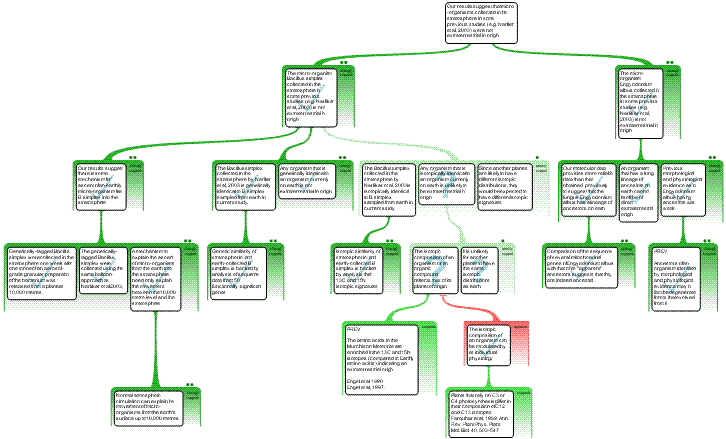The Science Of Scientific Writing Synthesis Exercise
PART I: Paragraphs and Sentences
SET A: Paragraphs: One Main Sentence
SET B: Paragraphs: With an Introduction
SET C: Paragraphs: Main Sentence Last
PART II: The Paper and its Sections
SET 1: Argument Parts
SET 2: Indicator Words
SET 4: Locating Arguments in Prose
SET 5: Rationale's Essay Planner
SET 6: Evidence in Arguments: Basis Boxes
Synthesis 1: Position-Early Paragraphs
Synthesis 2: Position-Final Paragraphs
Synthesis 3: Writing a Discussion I
Synthesis 4: Writing a Discussion II
Synthesis 4 - Writing up a Discussion II
Exercise
The map below (which needs to be dragged to the workspace) summarises the argument that will form the backbone of the Discussion section of a paper YOU are writing. Unless otherwise noted on the map (and see Introduction below for further clarification) ALL the results (imaginary) referred to are yours, and have already been included in a Results section (which you will just have to imagine). Note this is a modified version of a map you may have already done in Set 8 - it has been changed to emphasise the authors' contribution, and to make the science clearer.
A hard-copy printout of this map will also be made available to you in class.
A brief Introduction follows.
Introduction
Scientists have often pondered whether life of earth had an extraterrestrial origin, with most work focusing on life-forms or organic compounds that may have hitched a ride on a meteorite in the distant past. Another avenue of study has examined the possibility of organisms, or their spores, "raining down" upon earth as part of a living cosmic shower. This idea was tested during the late 90's and in the early part of the next decade by a team led by Narlikar in Hyderabad. They ran a series of tests where balloons were released into the stratosphere (above 25,000 metres) and then retrieved. Using stringent procedures to avoid contamination before release and upon retrieval, their collection equipment in the balloons yielded three types of micro-organisms, all known on earth: nanobacteria, Bacillus simplex, and the fungus Engyodontium albus (they referred to this by an earlier name). They argued that in the absence of any extraordinary meteorological events (which they had ruled out for the period leading up to the time of collection) it is not possible that the organisms entered the stratosphere from the earth, and that therefore they must have an extra-terrestrial origin.
No further work has yet followed up the results of Narlikar's team. If samples of the proposed extra-terrestrial organisms supplied the earth with their counterpart species many millions of years ago, then one would expect that in the intervening time, molecular and isotopic divergence between the extraterrestrial and current (terrestrial) populations would have occurred. At a more fundamental level, we also feel the previous authors have placed too much weight on findings that involve currently-occurring earth species, especially one with such a well-documented ancestry as Engyodontium albus. If Engyodontium albus is of extraterrestrial origin, then either (1) all of its apparent ancestors must be as well, which is highly unlikely or (2) the ancestors are only apparent as ancestors because of their simpler nature, but are in fact descendants of Engyodontium albus that have undergone evolutionary degeneration. Our concerns in this area make us interested in testing the assumption of the previous paper that there is no possibility that earth-sourced micro-organisms can make their way into the stratosphere.
In this study we explore the three lines of uncertainty noted above. We have examined the genetic and isotopic divergence of terrestrial and "extraterrestrial " B. simplex, using organisms collected on earth, and some of the original stratosphere-collected samples of Narlikar. Sequence data from 50 functionally-significant genes has been analysed. For both samples, we have also analysed the 13C and 15N isotopic signatures. For Engyodontium albus, we have examined the sequences of several mitochondrial genes of both itself and of a number of what have been assumed to be (on the basis of morphological and physiological characters) its ancestors. Finally, we have released genetically-tagged samples of B. simplex in the lower atmosphere, and tested (using the same balloon methodology as Narlikar) whether they appear in the stratosphere a week later.
END of INTRODUCTION
Write up a Discussion section as follows:
* It should have at least 3 paragraphs. The first paragraph should be Point-final and provide a brief map for the main body of the Discussion. All the paragraphs in the main body should be point-early. There should be a concluding paragraph, which can be point-early or point-final, as you wish. (So as I can determine your paragraphs more easily, space them apart by one line - you can do this in a Rationale Note box by hitting Shift-Enter.
* Make it clear that it is YOUR work that is being discussed: e.g. by referring to "our results", "we" etc.
* Look for opportunities to apply some of the story-telling strategies you have just read about
